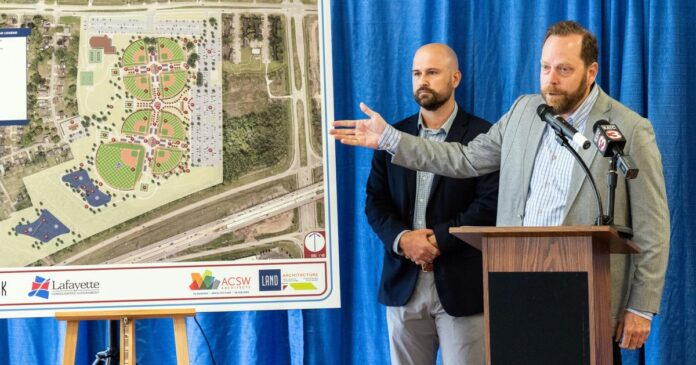Participation in youth soccer in Lafayette, for whatever reason, in recent years has been double the national average.
That’s according to Michael Ritch, who has been the director of the Cajun Rush/Lafayette Youth Soccer Association for the last 15 years. It has spilled into Broussard, Youngsville and now Carencro, and there will likely be another spike in interest that usually comes in World Cup years.
Many games are played at Moore Park, which holds 27 fields at its site in northwest Lafayette. It’s where many of the big tournaments are held. Soccer may not be a big of a draw for tournaments featuring team from out of town as baseball and softball do, but maybe that could change.
Last week Mayor-President Josh Guillory and others announced $25 million in upgrades to both Moore Park and Brown Park that will make both facilities a bigger draw.
Here’s the thing that Ritch noted makes Moore Park stand out from others like it in the state and the region: a high number of fields all in one place.
“They want to play on nice fields, and parents want it to be easy,” he said. “For a long time Moore Park hasn’t necessarily been easy. This facility makes this area kind of the heart of Louisiana soccer. And our goal is to bring all of those things here, all those people here, to showcase it. I’ve been all over the country, and that’s going to be as nice as any place you can go.”
The improvements include upgrade 11 improved surfaces along with a soccer stadium that can seat 1,200 people and will include a press box. Parking area will ring the park along the northwest side and connect the two sides of the park, while the second phase of upgrades could include an indoor facility.
Brown Park will get three more fields along with other amenities, part of the effort to turn each into what officials referred to as “super complexes.”
In the race to build better facilities by cities around the state and the region as part of the youth sports tourism industry, the moves were a significant step forward. But much work remains.
“This is the blueprint of how to grow quality of life,” Lafayette Travel President and CEO Ben Berthelot said. “The youth sports market is our fastest-growing market. Summertime used to be a really slow time, and last July was one of our best months on record. We just hosted a big softball tournament in November. So the demand is there.”
Lafayette Parish has strengths to continue to grow that market and better compete with other cities for sports tourism dollars, according to an analysis Berthelot’s agency commissioned on the state of the parish’s facilities. Diamond facilities at the Broussard and Youngsville sports complexes rank nationally, and the city’s central location is ideal.
Its weaknesses are also significant, but there’s opportunity in what continues to be a growing market both regionally and nationally. This year the area hosted 113 events, which led to over 46,000 hotel room nights and an economic impact of over $23 million, which was almost double from 2020’s totals.
With soccer, the area has a few tournaments it hosts each year — the Cajun Classic, the Cajun Lagniappe tournament in the spring, a state tournament that usually involves over 100 teams and a high school tournament early in the year that brings out college coaches.
“We want to provide a place that’s more family-friendly that can draw those families in for more than just a soccer game,” he said. “I have some ideas with different things that we might be able to do once this once this addition gets done. Then I think it’s kind of the sky’s the limit of what you can kind of brainstorm that you can do.”
The weaknesses
The sports tourism industry’s impact on Lafayette has been well-documented, and it’s that way across the state and the country as both youth sports programs and the megacomplexes to support them continue to get bigger.
The Aspen Institute, in its annual State of Play report released in November, cited how the travel sports programs have surged back since the COVID-19 shutdowns. The average family paid $883 annually for one child’s primary sport, a number that is still down from pre-pandemic totals, while wealthier families spent four times more on their child’s sport than the poorest families.
And megacomplexes are being built across the country, giving way to a fierce arms race among cities. In Westfield, Indiana, just north of Indianapolis, a sports complex spans 400 acres and includes 26 baseball and softball diamonds, 31 fields for soccer, football or lacrosse and an indoor facility that can hold up to eight courts for basketball or volleyball.
In Louisiana and the region, the competition is “hypercompetitive,” said Jon Schmieder, founder and CEO of the Huddle Up Group, which did the analysis. The city of West Monroe recently got ahead of other cities when it started work on a 112,000-square-foot indoor facility that officials predict will result in a $21.5 million impact and 300 full and part-time jobs.
A “serious lack of indoor facilities” is the area’s biggest weakness, he said. Indoor facilties can house contests for pickleball, now the fastest-growing sport in the U.S.
“That’s typical of all the Louisiana destinations I’ve worked with,” Schmieder said. “That’s why West Monroe is building one right now. They realized that no one in this state has good hardwood facilities. There’s no indoor hardwood space anywhere on the I-10 corridor. The Youngsville facility is the best one you have, but (it has) only two courts, and that’s not going to move the needle for tournament play.”
The report also cited how the region the lack of a central location for sports and entertainment, noting how the venues, hotels and restaurants are spread out. Having those locations huddled together can reduce travel and make operations easier.
It also cited the lack of full-service hotels in the area and having only one hotel next to the Cajundome. The DoubleTree by Hilton is the parish’s only full-service hotel.
How to keep up
To stay in the arms race and continue enhancements like at Brown and Moore parks, the parish needs a dedicated funding source, Schmieder said. Currently the parish has a 4% hotel occupancy tax, which Schmieder noted is the lowest hotel tax of any of the 300-plus agencies his group has studied.
Several communities around the country have raised their hotel tax rates to fund sports facility improvements, including Shreveport and its recent increase to its rate that helped fund its national marketing program as well as the Independence Bowl.
“We have destinations that we work with that are in the low teens,” he said. “I don’t think you’re pushing the boundary at all. If you were to go create a 2% improvement district to then put in the cookie jar to then use it to build facilities, that will then drive more money back in the same cookie jar and then drive your 4% collection even higher.”
Lafayette Travel could benefit from having of a sports brand, such as a sports commission moniker. Sports officials seeking a site, he noted, want to make sure they are speaking with someone focused on sports and not just hotel rooms.
A regional master plan would also assist in growing facilities across the parish, he said.
“We’re at risk of doing something redundant if we don’t put it all on one piece of paper or in one location,” Schmieder said. “We want to make sure that we’re not allocating funds that might not be the best opportunity to then drive the room nights back.”










